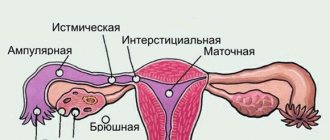Every woman should know how long her menstrual cycle lasts, as well as what the norm for a missed period may be. This information is very important.
A healthy woman has a cycle of 28-35 days. These figures are considered normal indicators, but are not mandatory - deviations are possible both upward and downward. If after 28-35 days menstruation has not begun, then we can talk about a delay. This may be a sign of pregnancy and may also mean that there are some health problems. In both cases, you should consult a gynecologist.
What kind of delay in menstruation can be considered acceptable? In gynecology, the norm is 5-7 days. A longer absence of menstruation indicates a pathological condition of the female body.
For whom is a long delay in menstruation not dangerous?
When your period has not started after 7 days, a health-conscious woman should be concerned. But for some, a delay of menstruation of even up to 6 months is not considered a deviation. These women include:
- young girls whose menstrual cycle has not yet fully established. Most often, this process can take from one to two years.
- girls who had their first sexual experience. They are most often in a stressful state, which leads to a delay in menstruation.
- women who have recently become mothers and are breastfeeding. During breastfeeding, the body releases the hormone prolactin, which blocks the maturation of eggs.
- women aged 40-45 years. During this period of life, the menstrual cycle most often goes astray. Bleeding may become scanty and linger. In women under 40-45 years of age, periods often “skip” occur.
Consequences and prevention
You cannot leave a situation to chance when a woman does not wait for “these” days. The lack of necessary treatment can lead to the transition of acute forms of diseases to chronic ones, infection of other organs, development of concomitant pathologies and infertility in the future.
In order not to risk your health, it is important to determine the cause of the absence of menstruation as early as possible and begin treatment.
To prevent such problems, women are advised to adhere to the following tips:
- visit a gynecologist twice a year for a routine examination;
- maintain a healthy lifestyle, which includes a balanced diet, giving up bad habits, and moderate physical activity;
- have a regular sex life;
- use reliable contraception.
Normally, the delay can be from three to five days. But it is important to take into account the individual factor and characteristics of the woman’s body condition. In any case, a prolonged failure is a reason to be wary and go to the clinic. Timely diagnosis and treatment is a way to avoid the development of serious pathologies.
All information is provided for informational purposes. Do not self-medicate. At the first sign of disease, consult a doctor.
https://youtu.be/zjjkZonc5Fc
Factors influencing absence of menstruation
If the delay in menstruation is not due to pregnancy, you should immediately consult a doctor. The gynecologist will identify the causes of abnormalities in the cycle and prescribe appropriate treatment.
Among the reasons leading to the absence of menstruation are:
- nervous tension, stress, depression, lack of normal sleep. A stressful state can be either short-term or long-term. Severe emotional shock, shock, as well as physical and emotional stress can cause disruption in the menstrual cycle.
- diet, sudden weight loss. Women who adhere to a strict diet bring their body to a stressful state. When fasting or poor nutrition, the body is deprived of the required amount of vitamins and amino acids, hormonal imbalance occurs and, as a result, the absence of menstruation.
- obesity, rapid weight gain. Too much weight blocks the production of tarragon, which leads to the development of hyperandrogenism and delayed menstruation.
- high physical activity or mental stress.
- acclimatization when traveling, moving.
- taking hormonal drugs. When taking this group of medications, hormonal levels change, thereby disrupting the menstrual cycle.
- anovulation. A menstrual cycle without ovulation, that is, without egg maturation, can appear at any time in any woman. This is considered normal. The absence of menstruation for 5 days during an anovulatory cycle is not considered a pathology.
- diseases of the genital organs. These include polycystic ovary syndrome, inflammation of the appendages, uterine fibroids, endometriosis, as well as inflammatory diseases of the genitourinary system (cystitis, adnexitis).
- gynecological procedures. Changes in the menstrual cycle can be caused by curettage, cauterization of erosive conditions of the cervix, colposcopy, hysteroscopy, and abortion.
When is delay normal?
At certain points in a woman’s life, her periods may be late, and this is considered as normal. Let's consider situations where the delay is a normal process that does not require immediate medical intervention.
Delayed menstruation in adolescents can be periodically observed for 2 years after the first menstruation. During this period, critical days may be irregular and have varying intensity. In adolescence, a delay can be caused by intense sports activities, emotional overexcitation, underdevelopment of the genital organs or an advance in their development. If a girl’s menstrual flow is not too heavy and there is no pain in the lower abdomen or lower back, then the normal delay at this age is 2-3 months. If you have any suspicious symptoms, you should immediately go to a gynecologist.
If, along with the delay, facial hair begins to appear on the girl, her voice becomes rougher, her breasts develop poorly and a male body type is formed, consultation with a gynecologist and endocrinologist is necessary, since this may be a serious hormonal disorder, the consequence of which is often infertility and health problems.
In women of reproductive age, there are many other reasons besides pregnancy that can cause absence of menstruation even for a very long period:
- Abortion and curettage lead not only to disruption of the uterine mucosa, but also to hormonal changes, which often result in delayed menstruation. It takes some time to recover after surgery, so the normal situation is the absence of regulation after curettage for 10-30 days;
- If a woman has a normal pregnancy, then her periods should not occur throughout the entire period of gestation, but after childbirth, the arrival of the first menstruation depends on the type of feeding the baby. During lactation, regulation may not be present throughout the entire period of breastfeeding. It is quite a normal situation when they begin to walk only 1-2 months after the complete cessation of breastfeeding. When early complementary feeding begins, regulations can be restored 3-4 months after birth. If the child is bottle-fed from birth, then the mother’s menstruation occurs after 30 days and after the cycle has been fully restored, it comes monthly;
- the cause of the delay can be both gynecological diseases and health problems in general;
- There are hormonal drugs that artificially delay the onset of menstruation. They are not recommended to be used more than once every six months, since frequent changes in the menstrual cycle can lead to permanent irregularities, complete absence of menstruation and diseases of the reproductive system;
- Hormone replacement therapy, which uses drugs containing progesterone, can cause the lack of regulation.
But after 45 years, irregular menstruation may indicate a decline in reproductive function and the onset of menopause. Periodic delays lasting from 10 days to six months are associated with aging of the ovaries and a decrease in estrogen levels. At this time, both the duration and abundance of the regulation changes. The number of cycles without ovulation increases, although the possibility of conception still remains, so women during menopause should use contraception for another year after the last menstruation. Since after 45 years the likelihood of cancer also increases, a delay does not always mean the onset of menopause, which means that such a situation requires mandatory consultation with a doctor.
Delay of menstruation for more than 3 days
A delay of 4 to 7 days in menstruation is normal for some women. This is a kind of restructuring of the body, a reaction to stress, moving or excessive physical or mental stress.
If a woman has not had her period for more than three days and the pregnancy test is negative, she should consult a doctor. He will help determine the cause of this failure and prescribe the necessary treatment.
If there is a slight change in hormonal levels, then they usually talk about such a thing as “ovarian dysfunction”. The cause of such a failure may be a disruption in the body's endocrine system.
Menstruation and the menstrual cycle
Critical days are a natural physiological process in the body of every sexually mature woman, which is the beginning of a new menstrual cycle. During menstruation, exfoliated endometrium is removed from the uterine cavity. This occurs due to the fact that the egg was not fertilized, which means that conception did not occur, and the body gets rid of unnecessary material, a kind of cleansing occurs. The first menstruation begins in girls at the age of 12-13 years, from this moment the body prepares monthly for a possible pregnancy, but if its expectations are not met, critical days begin again. This process is regular; normally, the cycle length varies from 21 to 35 days.
For some reasons, the regularity of the cycle may be disrupted; normally, the delay can last no more than 7 days.
The cause of cycle disturbances in this case may be stress, moving or other minor external factors. If there are no delays in the next cycle, then there is no need to worry about this. But there are a number of factors that can cause a delay for a longer period, and medical intervention may be necessary to eliminate them.
Consequences
If the absence of menstruation is due to hormonal changes or any gynecological diseases, this can lead to the formation of malignant neoplasms. If this process is not paid attention to, such tumors may become inoperable.
If you do not pay proper attention to inflammation of the genitourinary system, it can become chronic, which in turn can lead to infertility.
To prevent such severe consequences, you should consult a doctor in time. The gynecologist will prescribe the necessary tests, ultrasound examination of the pelvic organs, computer or magnetic resonance imaging of the brain. Early diagnosis and correct diagnosis will allow you to quickly begin treatment.
What to do if a woman has a delay in menstruation? The first step is to make sure that this does not indicate pregnancy. If you have not had unprotected sexual intercourse or the test is negative, you need to remember if there have been any stressful situations or increased physical activity recently. It is necessary to visit a gynecologist. He will prescribe all the necessary tests and determine the course of treatment. Only a doctor can definitely answer the question about the cause of menstrual irregularities. Do not forget that inattention to the problem or self-medication can lead to irreversible consequences.
What is the norm
If a girl’s menstrual cycle is not particularly regular, then she may not pay attention to slight delays in regulation, but the situation is completely different for women with a regular cycle. For them, any deviation from the norm can become a reason for panic; in order to prevent this, you should know the delay standards, that is, permissible deviations from the established cycle:
- 1-3 days is an acceptable delay in menstruation, which in most cases is considered normal and does not require special attention. The absence of menstruation for such a short period of time can be caused by slight hormonal fluctuations, as well as the peculiarities of the nervous system;
- 4-7 days – such a delay is also allowed. If a woman’s health is normal, there is no need to see a doctor. Menstruation delays of this duration occur due to stress, colds and changes in diet. This may also mean that the egg was fertilized, but could not implant in the uterine cavity, which led to pregnancy failure;
- 8-30 days - a delay within such limits can be considered normal only when pregnancy occurs. To make sure of this, it is enough to take a regular pregnancy test or take a blood test for hCG, which begins to rise sharply after conception. If the egg is fertilized 8-12 days after ovulation, then a woman may mistake implantation bleeding for menstruation, which accompanies the attachment of the zygote to the endometrium. If there is no pregnancy, then the absence of regula may mean inflammation of the uterus and appendages, the presence of cancer or ovarian dysfunction;
- 2-6 months is the maximum delay in menstruation, which may indicate the onset of early menopause due to genetics, stress, endocrine diseases, as well as problems with the nervous or reproductive systems. The longest period of absence of menstruation during menopause is 1 year.
Diagnostics
Comprehensive diagnostics includes:
- Measuring basal temperature. It is carried out to check for ovulation. The procedure must be repeated several times a day, the readings obtained are noted in a special chart. A sharp jump above 37 degrees indicates ovulation.
- General blood and urine analysis.
- Blood test for hormones. Allows you to identify deviations from the norm and the possible consequences of this condition.
- Ultrasound of the pelvic organs. Helps determine the presence of pregnancy, tumors and pathologies.
- Tests to detect sexually transmitted diseases.
- Computed tomography or magnetic tomography. The examination helps to study the condition of the pituitary gland.
The examination will help determine the cause of the long delay and select the correct treatment method.
Ultrasound of the pelvic organs will help identify abnormalities.
Delayed periods at different ages
Even more interesting:
Tongue with HIV infection photo
Yarina or Dimia
Often transitional periods that occur not only in adolescence, but also in adulthood, are accompanied by disruptions in the menstrual cycle.
Delays in adolescence
The onset of puberty is associated with a sharp change in hormonal levels in the body. Over the course of 2 years, fluctuations occur, due to which periods come irregularly and have variable duration and intensity. The length of the delays is influenced by emotional excitability, intense sports activities, lag or advance in the development of the genital organs.
If a girl’s bleeding is not too heavy, there is no severe pain in the groin area and lower back, and her periods are not accompanied by bleeding, then a delay of 2-3 months can be considered the norm. If there are dangerous symptoms of pathology, you should consult a gynecologist about the causes.
Delay due to illness
How many days can a woman have a delay in her period? It’s different for everyone; there are patients who miss their period for several months. You need to worry if the delay period exceeds 5-7 days. Then you must definitely visit a gynecologist who will make a diagnosis.
Diseases that may cause delay:
- Inflammatory diseases affecting the genital organs. Symptoms of these diseases are abdominal pain and discharge.
- Oncological pathologies of the genital organs.
- Polycystic ovary syndrome. With this disease, a woman gains weight, her hair growth on her face, arms, and back increases, her hair quickly becomes oily and irritability increases. It occurs due to an increase in the level of the male hormone testosterone in the blood.
- Corpus luteum cyst of the ovaries. The reason for its appearance is hormonal imbalance.
This problem can appear after an abortion, an ectopic pregnancy, a frozen pregnancy, or when a woman undergoes uterine curettage. In this case, not only hormonal changes are to blame, but also mechanical injuries that can occur during the procedure.
What is considered a delay?
Normally, the interval between menstruation should be 21-35 days. For some women they occur after 21-24 days, for others after 26-29, and for some after 32-35 days. There are also cases when a woman has a regular cycle, but its duration is less than 21 days or up to 40 days. The explanation may be a genetic feature of the organism.
It is believed that a healthy woman's periods come normally when the delay is no more than 7 days. But this does not mean that if menstruation occurs with a longer break, then the cause is necessarily pathology.










